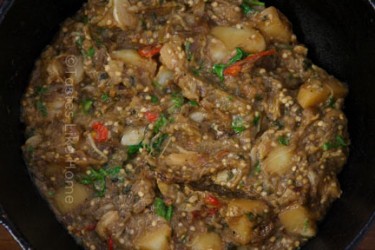Hi Everyone, I’ve lamented about it often enough but just in case your memory fails you, let me offer a refresher. While growing up, Sunday morning breakfast was fried (sautéed) eggplant and potatoes with lots of sweet onions and tomatoes cooked until just tender. The baigan and potatoes would be served in heaped spoonfuls accompanied by homemade bread and large mugs of sweet milky tea.
As appetizing as it looked, I could never enjoy the breakfast baigan and potatoes; I always ate the potatoes, tomatoes and onions and pushed the eggplant to one side of the plate. There was and still is something about the way in which my mom loves and cooks eggplant that I do not like. I know that she is not alone in this because I have seen very many people who like eggplant cook it as wholesome as they can and I know that it is because they enjoy the texture and flavour of eggplant in particular ways.
 My mother likes her eggplant cooked with the skin on and cut into thick slices. Once in the pan, she does not like too much tossing and turning of the eggplant that would result in the eggplant slices losing their shape or, heaven forbid, being mashed.
My mother likes her eggplant cooked with the skin on and cut into thick slices. Once in the pan, she does not like too much tossing and turning of the eggplant that would result in the eggplant slices losing their shape or, heaven forbid, being mashed.
One day, a long, long time ago (I was in my single digits), my eldest cousin, Shanti, was visiting and was tasked with cooking lunch while mom and my aunt were out shopping. Mommy left instructions for Shanti to cook baigan and chicken. When she was done cooking, Shanti took out lunch for my siblings, herself and me. I had never seen eggplant cooked that way before – there was not a strip of skin in sight, the flesh was smooth, pureed, the chunks of chicken popped up like little mounds, and the dish was reddish-brown from the tomato paste with which it was cooked. Man, I ate every morsel on my plate. Now that’s the way to have baigan I thought.
Mommy and my aunt arrived home and then headed to the kitchen to take out their food to eat. My mom opened the karahi in which the baign and chicken was cooked, the next thing I heard was mommy shouting for Shanti. The tone of her voice told me that something was wrong. Something was very wrong. Shanti arrived in the kitchen and mommy began her tirade – why was the baign peeled, why was it all mashed up and what is this colour? Poor Shanti, she just stood there rooted in one place. She did not have to respond, she wasn’t expected to. All she was supposed to do was to stand there, listen, and know that the next time mommy asked her to cook baigan to never make the mistake and cook it the way she had. I felt so sorry for my cousin and wanted to cry. For the first time ever in my little life, someone had cooked eggplant the way I could stomach it but here she was being berated for doing so.
It would not be until several years later, while on a visit to my maternal uncle’s home in the country, that I would be introduced to baigan choka (garlic stuffed eggplant, fire-roasted and mashed, almost pureed, along with fire-roasted tomatoes, hot pepper and thin slices of scallions/green onions) that I would discover a way in which I could eat and enjoy eggplant. It is a senses thing for me. I like the aroma of the smoke and char from the fire roasting, the flesh, void of any stringiness is mashed into a thick creamy mass, the roast garlic adding a unique flavour, the heat from the pepper that dances across my tongue and the delicate crunch from the red-head shallot. Instead of bread, my aunt had made sadha roti. A whole new world of eating eggplant had opened up to me.

As we grow – in every which way – our palettes change and adjust; things that we did not like when we were young, we find that we have grown to love and things that we grew up enjoying we can no longer tolerate. I cannot say that either scenario has been the case for me as it relates to eggplant. Still, the only way I can eat eggplant, the vegetable must be fire-roasted and mashed.
A few years ago I saw one of my blog friends post a recipe for curried baigan with tamarind. It wasn’t the curry, or the tamarind that caught my attention, but rather, that the eggplant was first fire-roasted, and then cooked into a dry curry. My heart raced with joy. You mean there is another fire-roasted way for me to enjoy eggplant than as a choka?
I took the inspiration from my friend’s recipe and set about creating my version of the dish. I added potatoes to my dry curry; it’s a texture thing for me. While I can eat the eggplant alone in a choka, as a curry, I needed to have something else to offset the eggplant. The addition of tamarind to the curry, well, that just took the dish into a whole new realm. The tartness that it brings to the curry makes it complex and compelling. Now this is the kind of baigan and aloo that I can eat on any Sunday morning with bread or roti and a big cup of sweet milky tea. It is definitely not my mom’s baigan and aloo.
Baigan & Aloo with Tamarind
INGREDIENTS
¼ cup chopped onions
1 tablespoon chopped fresh ginger
3 cloves garlic
Chopped hot pepper to taste
¼ teaspoon ground turmeric
1 teaspoon garam masala or ground geera (cumin)
3 tablespoons vegetable oil
1 ½ pound potatoes, peeled and cut into large chunks
Salt to taste
2 pounds baigan (eggplant), fire-roasted, skin removed and lightly mashed
2-inch round piece of ripe tamarind (or a piece with 4 – 5 seeds)
¼ cup chopped cilantro/coriander (optional)
DIRECTIONS
1. Grind the onions, ginger, garlic and pepper to a paste. Mix in the turmeric and masala or geera and set aside.
2. Heat oil in large pan on medium high heat until hot but not smoking. Add the masala paste, reduce heat to low and cook for 3 – 4 minutes or until very fragrant.
3. Turn heat to medium high, add potatoes and toss to mix with paste. Season with salt to taste; reduce heat to low, cover the pan and cook for 10 minutes.
4. At the end of the 10 minutes, add the eggplant and tamarind and toss to mix with the potatoes, season with salt to taste. Cook for 15 minutes covered.
5. Remove lid, turn heat to medium and give the mixture a toss/turn. Look for the tamarind and using the back of your pot spoon, mash it into the mixture and give another toss/turn. Be careful not to breakup too much of the potatoes. Taste for seasoning (salt) and adjust if necessary. Cook for a further 2 minutes.
6. Serve hot, garnished with cilantro.
Cynthia








